Genetic Code: Exploring the Rules of Life, Evolution, and Applications
VerifiedAdded on 2019/10/01
|9
|2767
|489
Essay
AI Summary
This essay provides a comprehensive exploration of the genetic code, beginning with its fundamental definition as the set of rules used by living cells to translate information into proteins from DNA and mRNA sequences. It details the role of ribosomes, transfer RNA, and codons in the translation process, highlighting the universal nature of the genetic code with certain exceptions. The essay traces the history of genetic code research, from early attempts to understand DNA's function to the discovery of the double helix structure and the subsequent understanding of how genes encode proteins. It explains the roles of nucleotides, bases (adenine, guanine, cytosine, and thymine), and the double-stranded DNA structure, including the concept of the genetic code as a battlefield where hosts and pathogens interact. The essay also covers the role of genes in the creation of an organism, the composition of the genome, and the significance of the exome. It also explores the potential applications of the genetic code, such as in coding passwords, emphasizing the complexity and importance of this biological concept. The essay concludes by discussing the relationship between genes, amino acids, and the resulting proteins, which shape the traits and characteristics of living organisms.

Running Head: Blog Writing
Blog Writing
Blog Writing
Paraphrase This Document
Need a fresh take? Get an instant paraphrase of this document with our AI Paraphraser
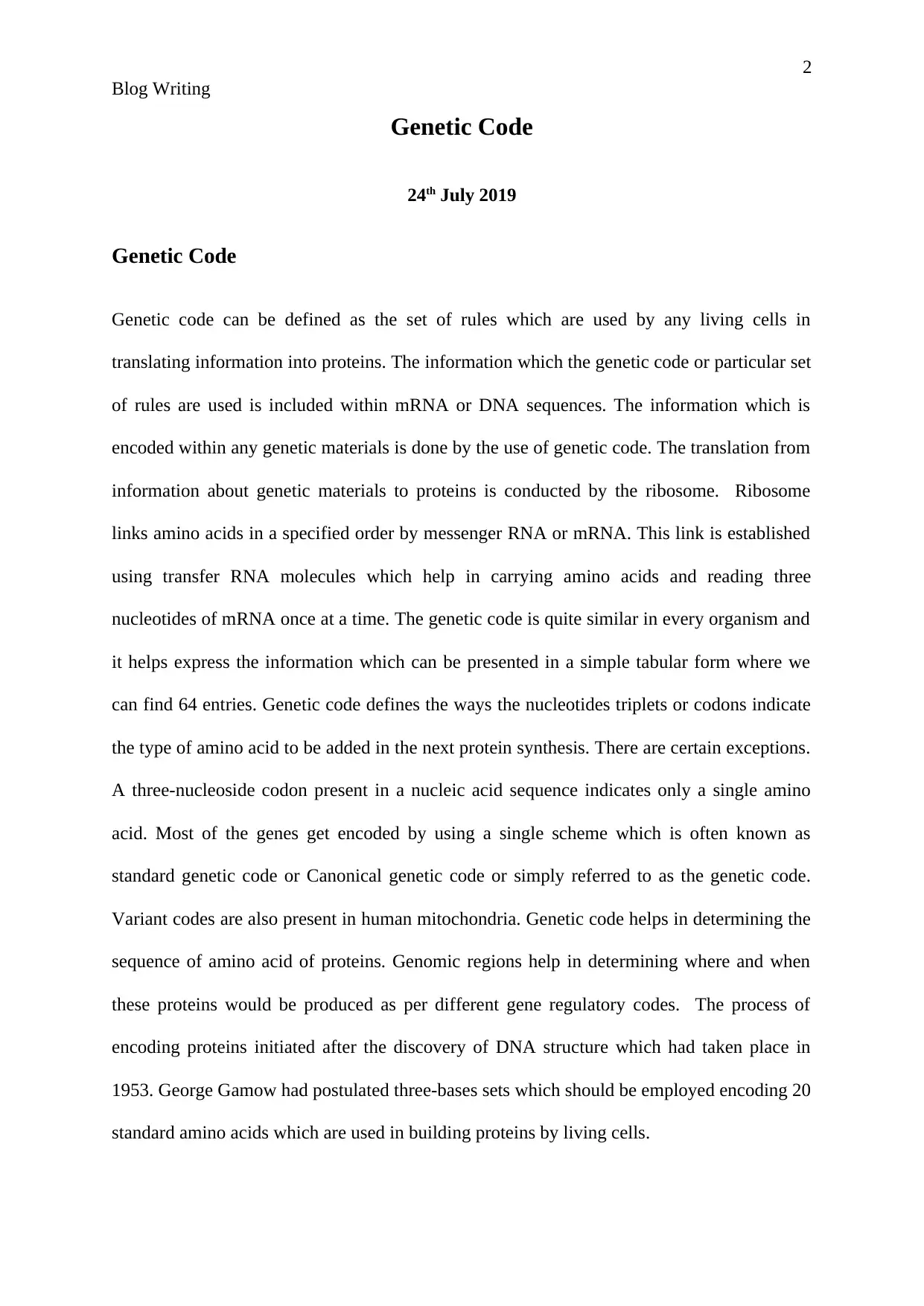
2
Blog Writing
Genetic Code
24th July 2019
Genetic Code
Genetic code can be defined as the set of rules which are used by any living cells in
translating information into proteins. The information which the genetic code or particular set
of rules are used is included within mRNA or DNA sequences. The information which is
encoded within any genetic materials is done by the use of genetic code. The translation from
information about genetic materials to proteins is conducted by the ribosome. Ribosome
links amino acids in a specified order by messenger RNA or mRNA. This link is established
using transfer RNA molecules which help in carrying amino acids and reading three
nucleotides of mRNA once at a time. The genetic code is quite similar in every organism and
it helps express the information which can be presented in a simple tabular form where we
can find 64 entries. Genetic code defines the ways the nucleotides triplets or codons indicate
the type of amino acid to be added in the next protein synthesis. There are certain exceptions.
A three-nucleoside codon present in a nucleic acid sequence indicates only a single amino
acid. Most of the genes get encoded by using a single scheme which is often known as
standard genetic code or Canonical genetic code or simply referred to as the genetic code.
Variant codes are also present in human mitochondria. Genetic code helps in determining the
sequence of amino acid of proteins. Genomic regions help in determining where and when
these proteins would be produced as per different gene regulatory codes. The process of
encoding proteins initiated after the discovery of DNA structure which had taken place in
1953. George Gamow had postulated three-bases sets which should be employed encoding 20
standard amino acids which are used in building proteins by living cells.
Blog Writing
Genetic Code
24th July 2019
Genetic Code
Genetic code can be defined as the set of rules which are used by any living cells in
translating information into proteins. The information which the genetic code or particular set
of rules are used is included within mRNA or DNA sequences. The information which is
encoded within any genetic materials is done by the use of genetic code. The translation from
information about genetic materials to proteins is conducted by the ribosome. Ribosome
links amino acids in a specified order by messenger RNA or mRNA. This link is established
using transfer RNA molecules which help in carrying amino acids and reading three
nucleotides of mRNA once at a time. The genetic code is quite similar in every organism and
it helps express the information which can be presented in a simple tabular form where we
can find 64 entries. Genetic code defines the ways the nucleotides triplets or codons indicate
the type of amino acid to be added in the next protein synthesis. There are certain exceptions.
A three-nucleoside codon present in a nucleic acid sequence indicates only a single amino
acid. Most of the genes get encoded by using a single scheme which is often known as
standard genetic code or Canonical genetic code or simply referred to as the genetic code.
Variant codes are also present in human mitochondria. Genetic code helps in determining the
sequence of amino acid of proteins. Genomic regions help in determining where and when
these proteins would be produced as per different gene regulatory codes. The process of
encoding proteins initiated after the discovery of DNA structure which had taken place in
1953. George Gamow had postulated three-bases sets which should be employed encoding 20
standard amino acids which are used in building proteins by living cells.
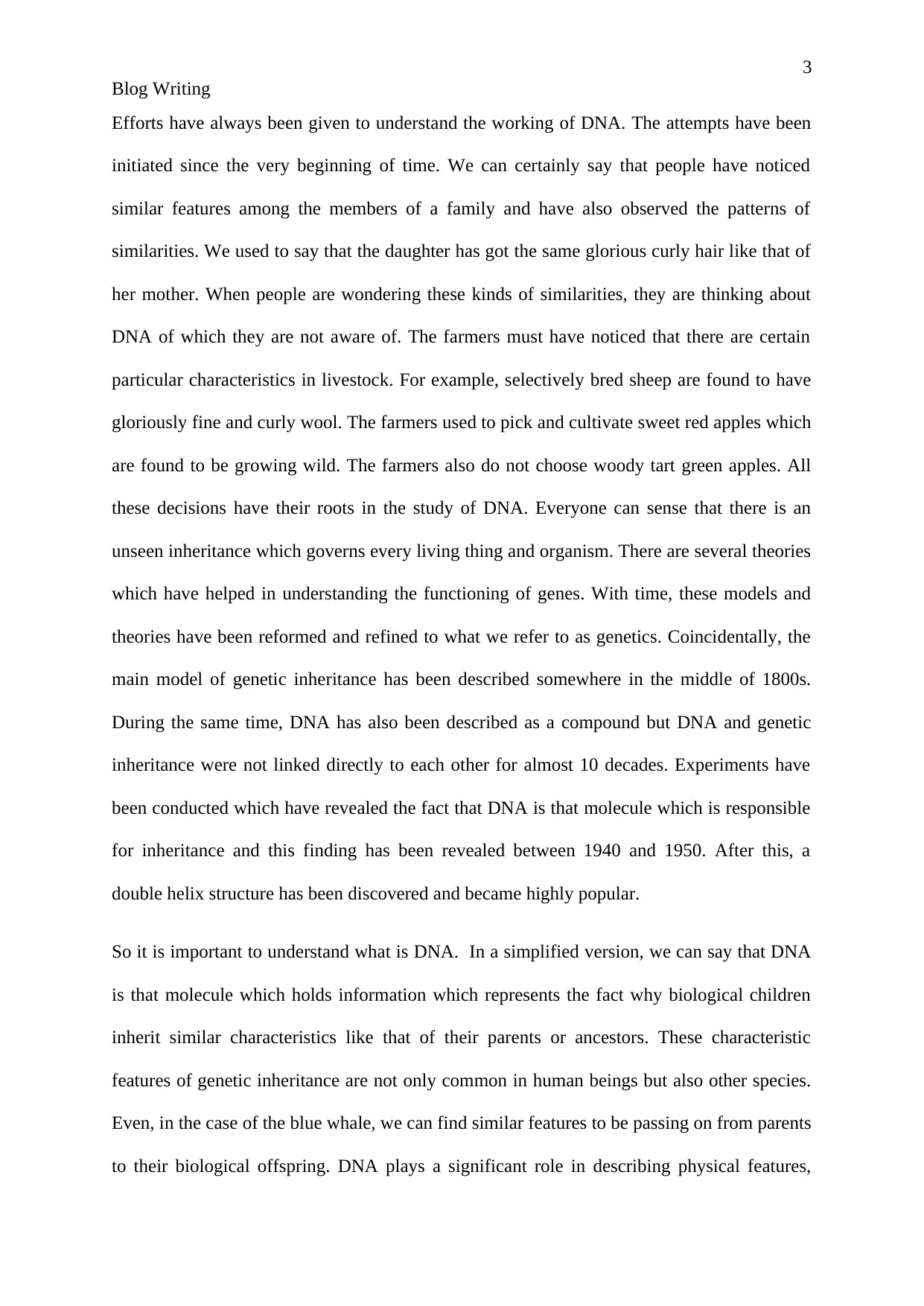
3
Blog Writing
Efforts have always been given to understand the working of DNA. The attempts have been
initiated since the very beginning of time. We can certainly say that people have noticed
similar features among the members of a family and have also observed the patterns of
similarities. We used to say that the daughter has got the same glorious curly hair like that of
her mother. When people are wondering these kinds of similarities, they are thinking about
DNA of which they are not aware of. The farmers must have noticed that there are certain
particular characteristics in livestock. For example, selectively bred sheep are found to have
gloriously fine and curly wool. The farmers used to pick and cultivate sweet red apples which
are found to be growing wild. The farmers also do not choose woody tart green apples. All
these decisions have their roots in the study of DNA. Everyone can sense that there is an
unseen inheritance which governs every living thing and organism. There are several theories
which have helped in understanding the functioning of genes. With time, these models and
theories have been reformed and refined to what we refer to as genetics. Coincidentally, the
main model of genetic inheritance has been described somewhere in the middle of 1800s.
During the same time, DNA has also been described as a compound but DNA and genetic
inheritance were not linked directly to each other for almost 10 decades. Experiments have
been conducted which have revealed the fact that DNA is that molecule which is responsible
for inheritance and this finding has been revealed between 1940 and 1950. After this, a
double helix structure has been discovered and became highly popular.
So it is important to understand what is DNA. In a simplified version, we can say that DNA
is that molecule which holds information which represents the fact why biological children
inherit similar characteristics like that of their parents or ancestors. These characteristic
features of genetic inheritance are not only common in human beings but also other species.
Even, in the case of the blue whale, we can find similar features to be passing on from parents
to their biological offspring. DNA plays a significant role in describing physical features,
Blog Writing
Efforts have always been given to understand the working of DNA. The attempts have been
initiated since the very beginning of time. We can certainly say that people have noticed
similar features among the members of a family and have also observed the patterns of
similarities. We used to say that the daughter has got the same glorious curly hair like that of
her mother. When people are wondering these kinds of similarities, they are thinking about
DNA of which they are not aware of. The farmers must have noticed that there are certain
particular characteristics in livestock. For example, selectively bred sheep are found to have
gloriously fine and curly wool. The farmers used to pick and cultivate sweet red apples which
are found to be growing wild. The farmers also do not choose woody tart green apples. All
these decisions have their roots in the study of DNA. Everyone can sense that there is an
unseen inheritance which governs every living thing and organism. There are several theories
which have helped in understanding the functioning of genes. With time, these models and
theories have been reformed and refined to what we refer to as genetics. Coincidentally, the
main model of genetic inheritance has been described somewhere in the middle of 1800s.
During the same time, DNA has also been described as a compound but DNA and genetic
inheritance were not linked directly to each other for almost 10 decades. Experiments have
been conducted which have revealed the fact that DNA is that molecule which is responsible
for inheritance and this finding has been revealed between 1940 and 1950. After this, a
double helix structure has been discovered and became highly popular.
So it is important to understand what is DNA. In a simplified version, we can say that DNA
is that molecule which holds information which represents the fact why biological children
inherit similar characteristics like that of their parents or ancestors. These characteristic
features of genetic inheritance are not only common in human beings but also other species.
Even, in the case of the blue whale, we can find similar features to be passing on from parents
to their biological offspring. DNA plays a significant role in describing physical features,
⊘ This is a preview!⊘
Do you want full access?
Subscribe today to unlock all pages.

Trusted by 1+ million students worldwide
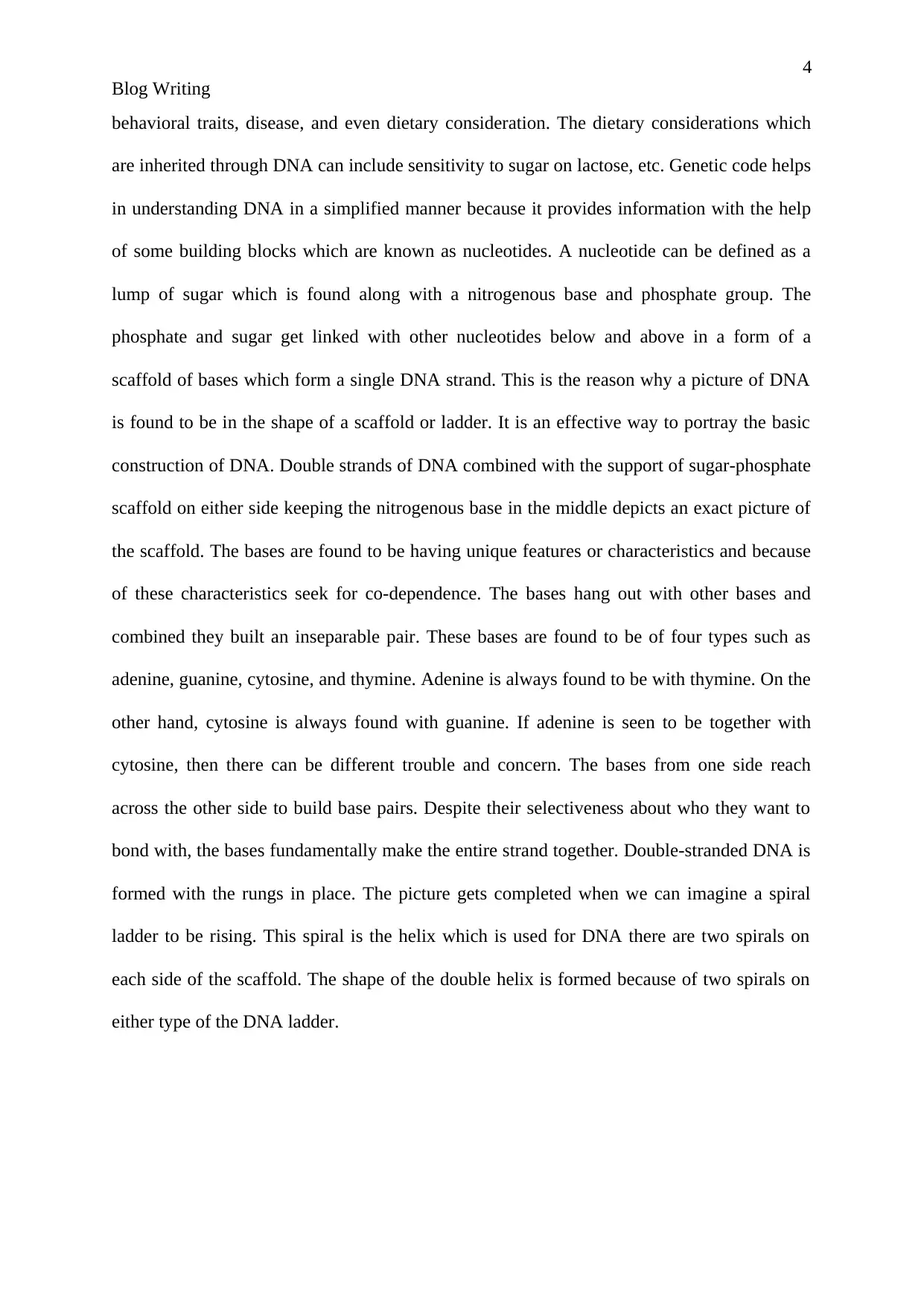
4
Blog Writing
behavioral traits, disease, and even dietary consideration. The dietary considerations which
are inherited through DNA can include sensitivity to sugar on lactose, etc. Genetic code helps
in understanding DNA in a simplified manner because it provides information with the help
of some building blocks which are known as nucleotides. A nucleotide can be defined as a
lump of sugar which is found along with a nitrogenous base and phosphate group. The
phosphate and sugar get linked with other nucleotides below and above in a form of a
scaffold of bases which form a single DNA strand. This is the reason why a picture of DNA
is found to be in the shape of a scaffold or ladder. It is an effective way to portray the basic
construction of DNA. Double strands of DNA combined with the support of sugar-phosphate
scaffold on either side keeping the nitrogenous base in the middle depicts an exact picture of
the scaffold. The bases are found to be having unique features or characteristics and because
of these characteristics seek for co-dependence. The bases hang out with other bases and
combined they built an inseparable pair. These bases are found to be of four types such as
adenine, guanine, cytosine, and thymine. Adenine is always found to be with thymine. On the
other hand, cytosine is always found with guanine. If adenine is seen to be together with
cytosine, then there can be different trouble and concern. The bases from one side reach
across the other side to build base pairs. Despite their selectiveness about who they want to
bond with, the bases fundamentally make the entire strand together. Double-stranded DNA is
formed with the rungs in place. The picture gets completed when we can imagine a spiral
ladder to be rising. This spiral is the helix which is used for DNA there are two spirals on
each side of the scaffold. The shape of the double helix is formed because of two spirals on
either type of the DNA ladder.
Blog Writing
behavioral traits, disease, and even dietary consideration. The dietary considerations which
are inherited through DNA can include sensitivity to sugar on lactose, etc. Genetic code helps
in understanding DNA in a simplified manner because it provides information with the help
of some building blocks which are known as nucleotides. A nucleotide can be defined as a
lump of sugar which is found along with a nitrogenous base and phosphate group. The
phosphate and sugar get linked with other nucleotides below and above in a form of a
scaffold of bases which form a single DNA strand. This is the reason why a picture of DNA
is found to be in the shape of a scaffold or ladder. It is an effective way to portray the basic
construction of DNA. Double strands of DNA combined with the support of sugar-phosphate
scaffold on either side keeping the nitrogenous base in the middle depicts an exact picture of
the scaffold. The bases are found to be having unique features or characteristics and because
of these characteristics seek for co-dependence. The bases hang out with other bases and
combined they built an inseparable pair. These bases are found to be of four types such as
adenine, guanine, cytosine, and thymine. Adenine is always found to be with thymine. On the
other hand, cytosine is always found with guanine. If adenine is seen to be together with
cytosine, then there can be different trouble and concern. The bases from one side reach
across the other side to build base pairs. Despite their selectiveness about who they want to
bond with, the bases fundamentally make the entire strand together. Double-stranded DNA is
formed with the rungs in place. The picture gets completed when we can imagine a spiral
ladder to be rising. This spiral is the helix which is used for DNA there are two spirals on
each side of the scaffold. The shape of the double helix is formed because of two spirals on
either type of the DNA ladder.
Paraphrase This Document
Need a fresh take? Get an instant paraphrase of this document with our AI Paraphraser
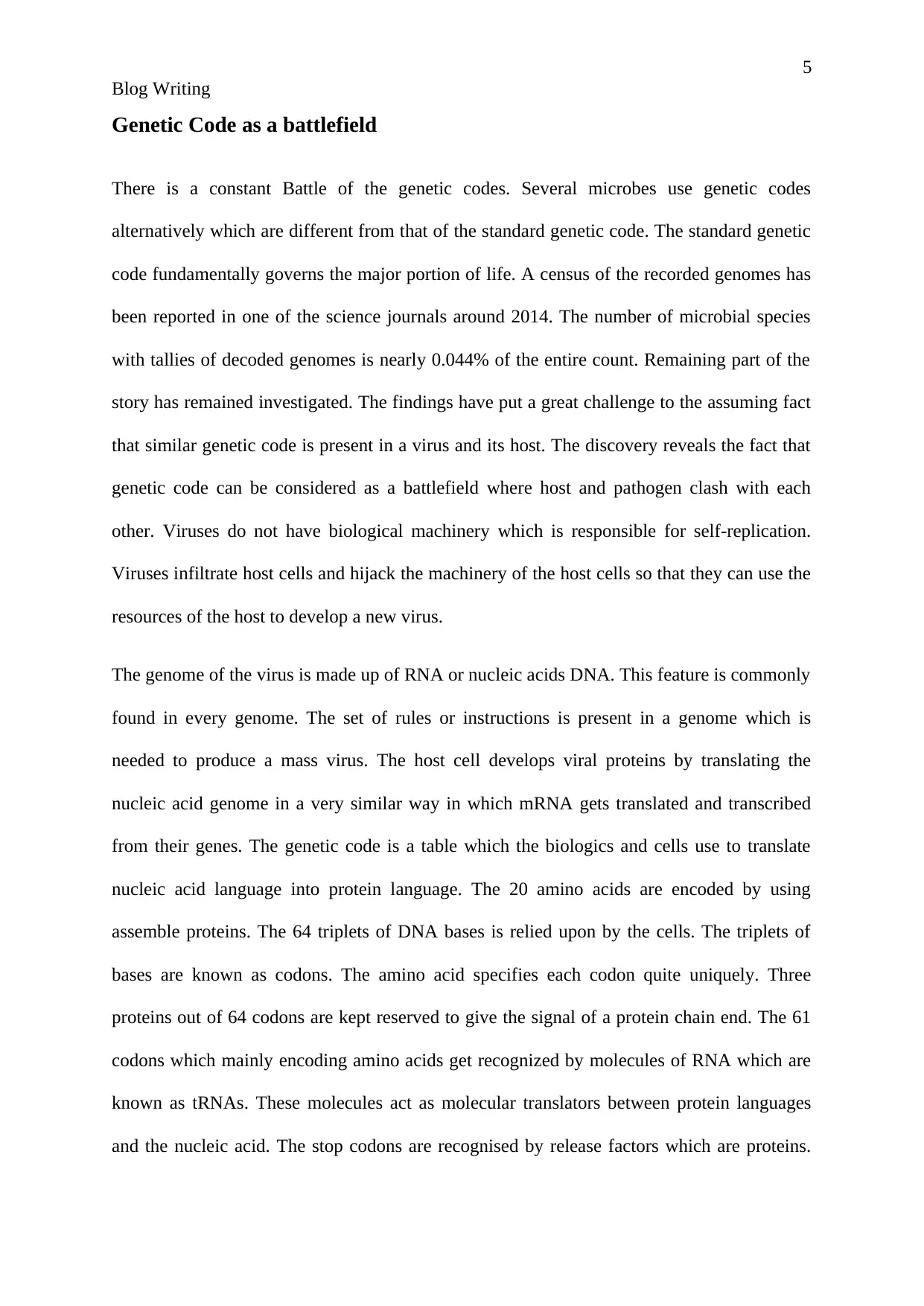
5
Blog Writing
Genetic Code as a battlefield
There is a constant Battle of the genetic codes. Several microbes use genetic codes
alternatively which are different from that of the standard genetic code. The standard genetic
code fundamentally governs the major portion of life. A census of the recorded genomes has
been reported in one of the science journals around 2014. The number of microbial species
with tallies of decoded genomes is nearly 0.044% of the entire count. Remaining part of the
story has remained investigated. The findings have put a great challenge to the assuming fact
that similar genetic code is present in a virus and its host. The discovery reveals the fact that
genetic code can be considered as a battlefield where host and pathogen clash with each
other. Viruses do not have biological machinery which is responsible for self-replication.
Viruses infiltrate host cells and hijack the machinery of the host cells so that they can use the
resources of the host to develop a new virus.
The genome of the virus is made up of RNA or nucleic acids DNA. This feature is commonly
found in every genome. The set of rules or instructions is present in a genome which is
needed to produce a mass virus. The host cell develops viral proteins by translating the
nucleic acid genome in a very similar way in which mRNA gets translated and transcribed
from their genes. The genetic code is a table which the biologics and cells use to translate
nucleic acid language into protein language. The 20 amino acids are encoded by using
assemble proteins. The 64 triplets of DNA bases is relied upon by the cells. The triplets of
bases are known as codons. The amino acid specifies each codon quite uniquely. Three
proteins out of 64 codons are kept reserved to give the signal of a protein chain end. The 61
codons which mainly encoding amino acids get recognized by molecules of RNA which are
known as tRNAs. These molecules act as molecular translators between protein languages
and the nucleic acid. The stop codons are recognised by release factors which are proteins.
Blog Writing
Genetic Code as a battlefield
There is a constant Battle of the genetic codes. Several microbes use genetic codes
alternatively which are different from that of the standard genetic code. The standard genetic
code fundamentally governs the major portion of life. A census of the recorded genomes has
been reported in one of the science journals around 2014. The number of microbial species
with tallies of decoded genomes is nearly 0.044% of the entire count. Remaining part of the
story has remained investigated. The findings have put a great challenge to the assuming fact
that similar genetic code is present in a virus and its host. The discovery reveals the fact that
genetic code can be considered as a battlefield where host and pathogen clash with each
other. Viruses do not have biological machinery which is responsible for self-replication.
Viruses infiltrate host cells and hijack the machinery of the host cells so that they can use the
resources of the host to develop a new virus.
The genome of the virus is made up of RNA or nucleic acids DNA. This feature is commonly
found in every genome. The set of rules or instructions is present in a genome which is
needed to produce a mass virus. The host cell develops viral proteins by translating the
nucleic acid genome in a very similar way in which mRNA gets translated and transcribed
from their genes. The genetic code is a table which the biologics and cells use to translate
nucleic acid language into protein language. The 20 amino acids are encoded by using
assemble proteins. The 64 triplets of DNA bases is relied upon by the cells. The triplets of
bases are known as codons. The amino acid specifies each codon quite uniquely. Three
proteins out of 64 codons are kept reserved to give the signal of a protein chain end. The 61
codons which mainly encoding amino acids get recognized by molecules of RNA which are
known as tRNAs. These molecules act as molecular translators between protein languages
and the nucleic acid. The stop codons are recognised by release factors which are proteins.
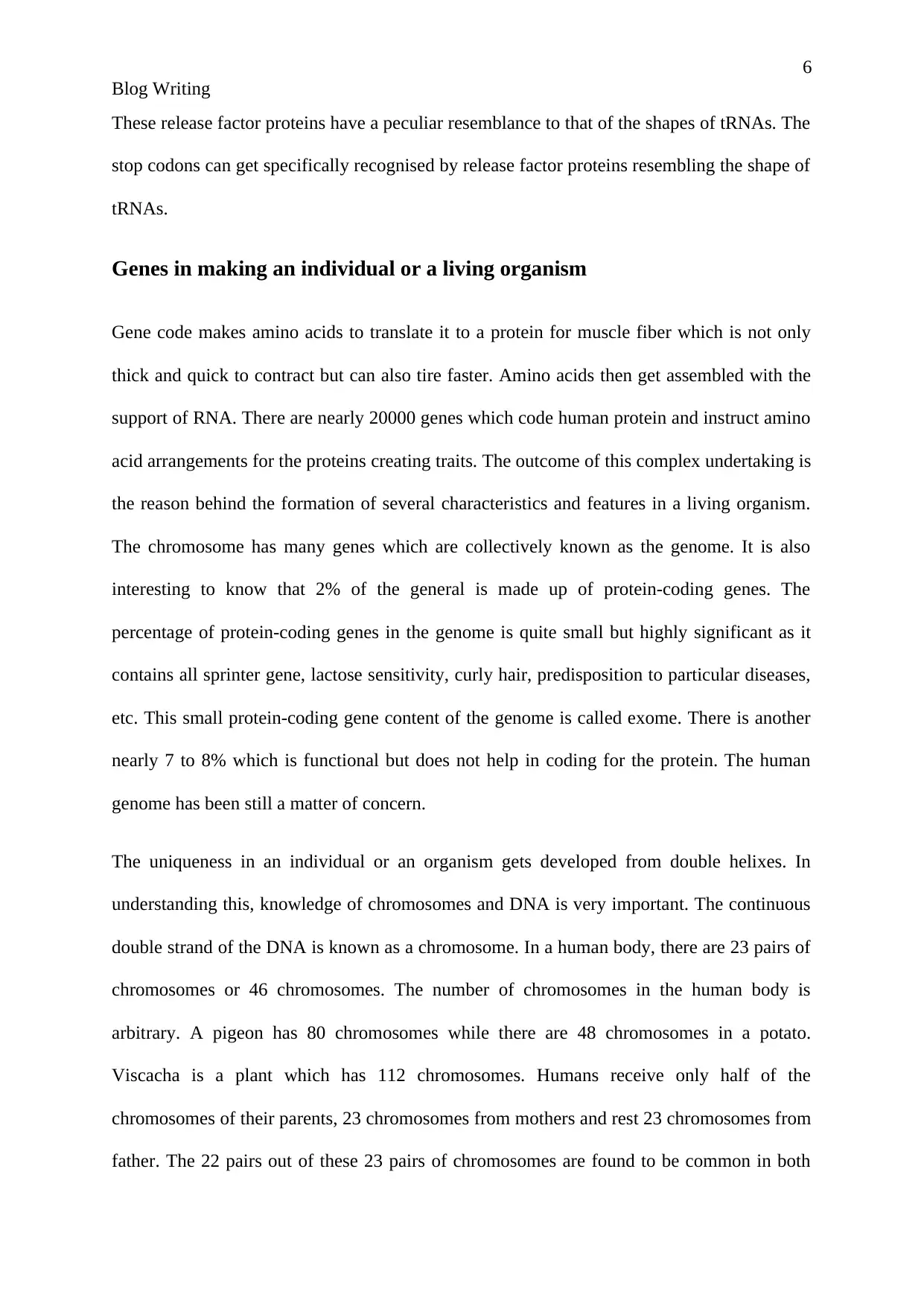
6
Blog Writing
These release factor proteins have a peculiar resemblance to that of the shapes of tRNAs. The
stop codons can get specifically recognised by release factor proteins resembling the shape of
tRNAs.
Genes in making an individual or a living organism
Gene code makes amino acids to translate it to a protein for muscle fiber which is not only
thick and quick to contract but can also tire faster. Amino acids then get assembled with the
support of RNA. There are nearly 20000 genes which code human protein and instruct amino
acid arrangements for the proteins creating traits. The outcome of this complex undertaking is
the reason behind the formation of several characteristics and features in a living organism.
The chromosome has many genes which are collectively known as the genome. It is also
interesting to know that 2% of the general is made up of protein-coding genes. The
percentage of protein-coding genes in the genome is quite small but highly significant as it
contains all sprinter gene, lactose sensitivity, curly hair, predisposition to particular diseases,
etc. This small protein-coding gene content of the genome is called exome. There is another
nearly 7 to 8% which is functional but does not help in coding for the protein. The human
genome has been still a matter of concern.
The uniqueness in an individual or an organism gets developed from double helixes. In
understanding this, knowledge of chromosomes and DNA is very important. The continuous
double strand of the DNA is known as a chromosome. In a human body, there are 23 pairs of
chromosomes or 46 chromosomes. The number of chromosomes in the human body is
arbitrary. A pigeon has 80 chromosomes while there are 48 chromosomes in a potato.
Viscacha is a plant which has 112 chromosomes. Humans receive only half of the
chromosomes of their parents, 23 chromosomes from mothers and rest 23 chromosomes from
father. The 22 pairs out of these 23 pairs of chromosomes are found to be common in both
Blog Writing
These release factor proteins have a peculiar resemblance to that of the shapes of tRNAs. The
stop codons can get specifically recognised by release factor proteins resembling the shape of
tRNAs.
Genes in making an individual or a living organism
Gene code makes amino acids to translate it to a protein for muscle fiber which is not only
thick and quick to contract but can also tire faster. Amino acids then get assembled with the
support of RNA. There are nearly 20000 genes which code human protein and instruct amino
acid arrangements for the proteins creating traits. The outcome of this complex undertaking is
the reason behind the formation of several characteristics and features in a living organism.
The chromosome has many genes which are collectively known as the genome. It is also
interesting to know that 2% of the general is made up of protein-coding genes. The
percentage of protein-coding genes in the genome is quite small but highly significant as it
contains all sprinter gene, lactose sensitivity, curly hair, predisposition to particular diseases,
etc. This small protein-coding gene content of the genome is called exome. There is another
nearly 7 to 8% which is functional but does not help in coding for the protein. The human
genome has been still a matter of concern.
The uniqueness in an individual or an organism gets developed from double helixes. In
understanding this, knowledge of chromosomes and DNA is very important. The continuous
double strand of the DNA is known as a chromosome. In a human body, there are 23 pairs of
chromosomes or 46 chromosomes. The number of chromosomes in the human body is
arbitrary. A pigeon has 80 chromosomes while there are 48 chromosomes in a potato.
Viscacha is a plant which has 112 chromosomes. Humans receive only half of the
chromosomes of their parents, 23 chromosomes from mothers and rest 23 chromosomes from
father. The 22 pairs out of these 23 pairs of chromosomes are found to be common in both
⊘ This is a preview!⊘
Do you want full access?
Subscribe today to unlock all pages.

Trusted by 1+ million students worldwide
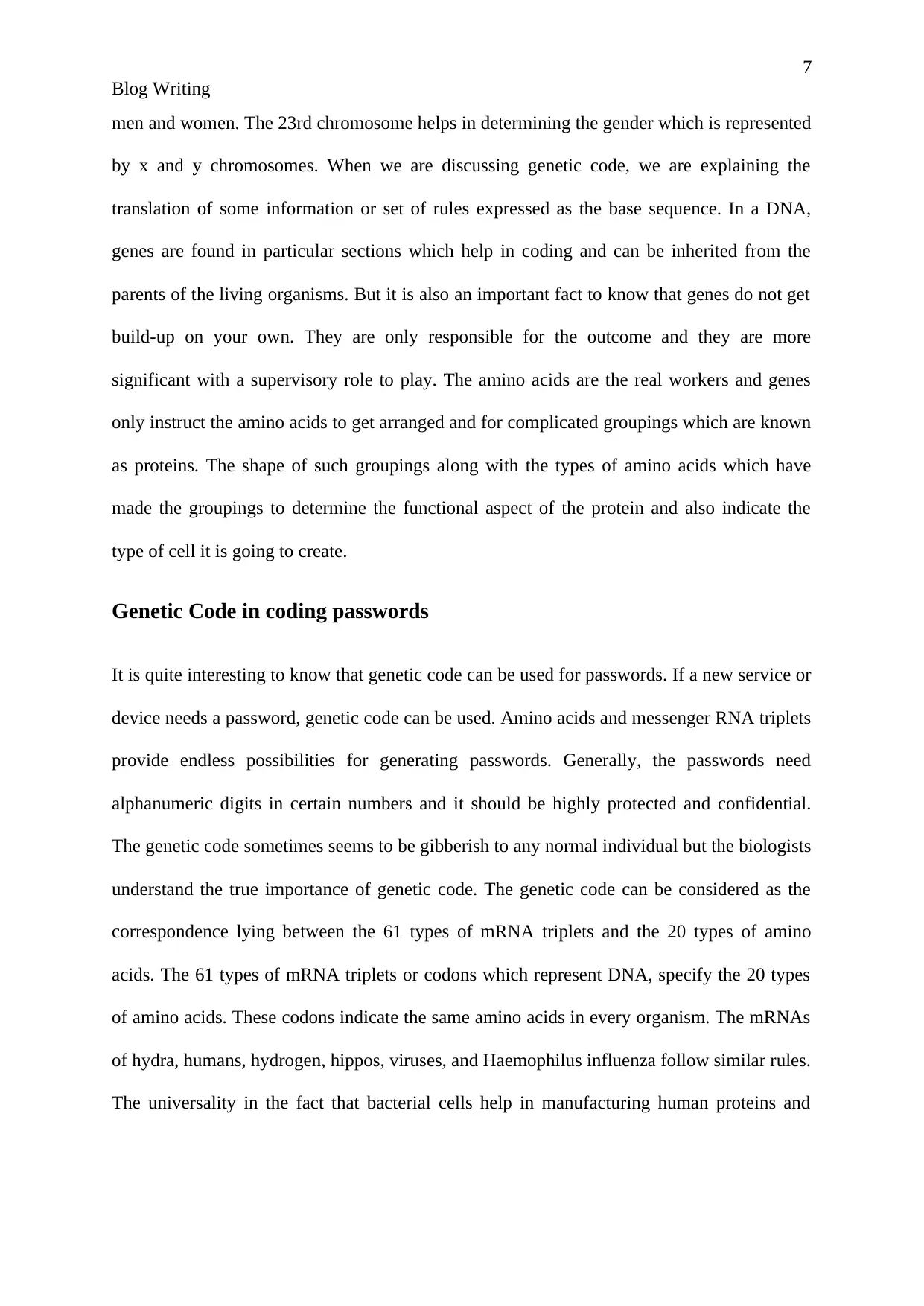
7
Blog Writing
men and women. The 23rd chromosome helps in determining the gender which is represented
by x and y chromosomes. When we are discussing genetic code, we are explaining the
translation of some information or set of rules expressed as the base sequence. In a DNA,
genes are found in particular sections which help in coding and can be inherited from the
parents of the living organisms. But it is also an important fact to know that genes do not get
build-up on your own. They are only responsible for the outcome and they are more
significant with a supervisory role to play. The amino acids are the real workers and genes
only instruct the amino acids to get arranged and for complicated groupings which are known
as proteins. The shape of such groupings along with the types of amino acids which have
made the groupings to determine the functional aspect of the protein and also indicate the
type of cell it is going to create.
Genetic Code in coding passwords
It is quite interesting to know that genetic code can be used for passwords. If a new service or
device needs a password, genetic code can be used. Amino acids and messenger RNA triplets
provide endless possibilities for generating passwords. Generally, the passwords need
alphanumeric digits in certain numbers and it should be highly protected and confidential.
The genetic code sometimes seems to be gibberish to any normal individual but the biologists
understand the true importance of genetic code. The genetic code can be considered as the
correspondence lying between the 61 types of mRNA triplets and the 20 types of amino
acids. The 61 types of mRNA triplets or codons which represent DNA, specify the 20 types
of amino acids. These codons indicate the same amino acids in every organism. The mRNAs
of hydra, humans, hydrogen, hippos, viruses, and Haemophilus influenza follow similar rules.
The universality in the fact that bacterial cells help in manufacturing human proteins and
Blog Writing
men and women. The 23rd chromosome helps in determining the gender which is represented
by x and y chromosomes. When we are discussing genetic code, we are explaining the
translation of some information or set of rules expressed as the base sequence. In a DNA,
genes are found in particular sections which help in coding and can be inherited from the
parents of the living organisms. But it is also an important fact to know that genes do not get
build-up on your own. They are only responsible for the outcome and they are more
significant with a supervisory role to play. The amino acids are the real workers and genes
only instruct the amino acids to get arranged and for complicated groupings which are known
as proteins. The shape of such groupings along with the types of amino acids which have
made the groupings to determine the functional aspect of the protein and also indicate the
type of cell it is going to create.
Genetic Code in coding passwords
It is quite interesting to know that genetic code can be used for passwords. If a new service or
device needs a password, genetic code can be used. Amino acids and messenger RNA triplets
provide endless possibilities for generating passwords. Generally, the passwords need
alphanumeric digits in certain numbers and it should be highly protected and confidential.
The genetic code sometimes seems to be gibberish to any normal individual but the biologists
understand the true importance of genetic code. The genetic code can be considered as the
correspondence lying between the 61 types of mRNA triplets and the 20 types of amino
acids. The 61 types of mRNA triplets or codons which represent DNA, specify the 20 types
of amino acids. These codons indicate the same amino acids in every organism. The mRNAs
of hydra, humans, hydrogen, hippos, viruses, and Haemophilus influenza follow similar rules.
The universality in the fact that bacterial cells help in manufacturing human proteins and
Paraphrase This Document
Need a fresh take? Get an instant paraphrase of this document with our AI Paraphraser
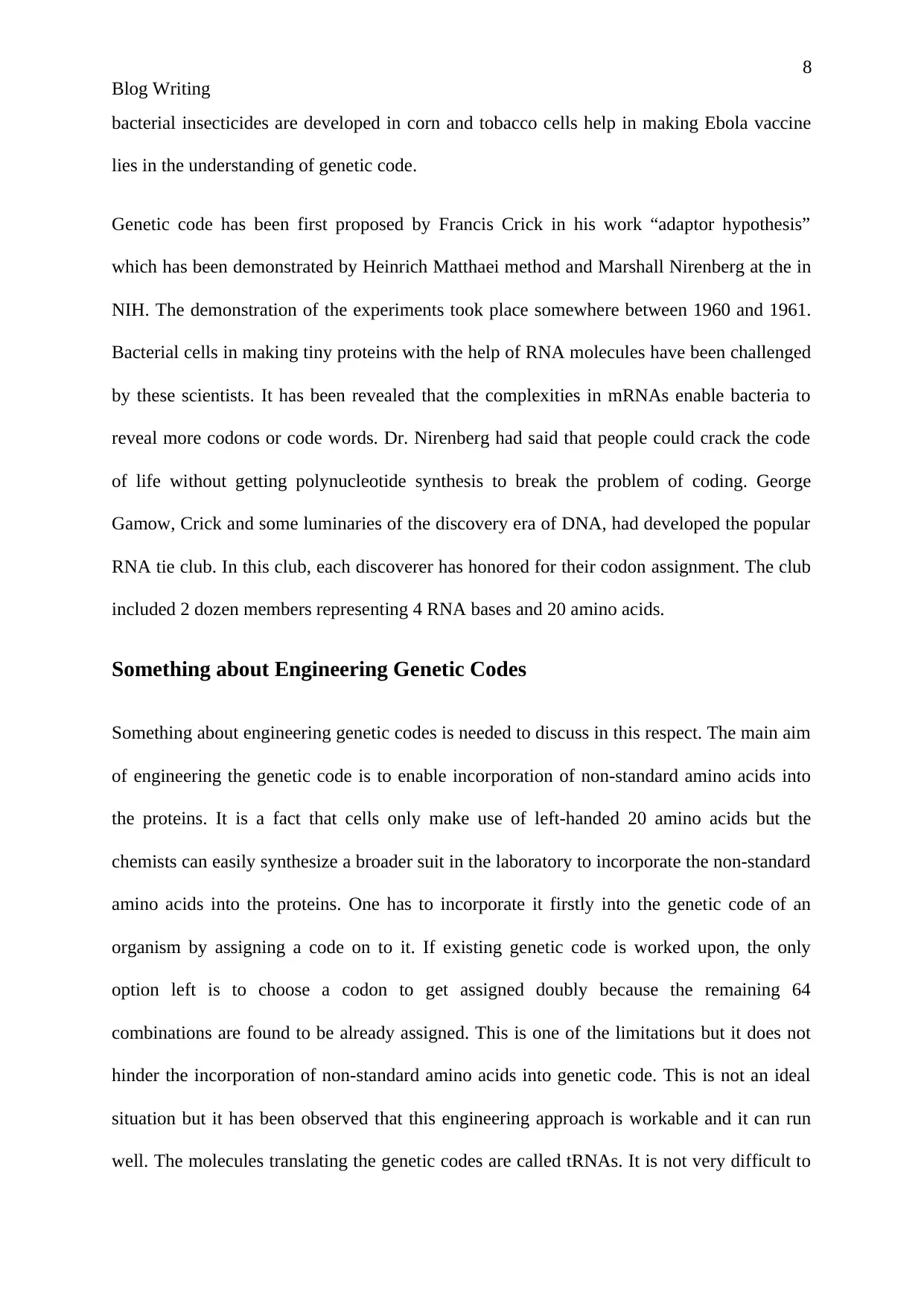
8
Blog Writing
bacterial insecticides are developed in corn and tobacco cells help in making Ebola vaccine
lies in the understanding of genetic code.
Genetic code has been first proposed by Francis Crick in his work “adaptor hypothesis”
which has been demonstrated by Heinrich Matthaei method and Marshall Nirenberg at the in
NIH. The demonstration of the experiments took place somewhere between 1960 and 1961.
Bacterial cells in making tiny proteins with the help of RNA molecules have been challenged
by these scientists. It has been revealed that the complexities in mRNAs enable bacteria to
reveal more codons or code words. Dr. Nirenberg had said that people could crack the code
of life without getting polynucleotide synthesis to break the problem of coding. George
Gamow, Crick and some luminaries of the discovery era of DNA, had developed the popular
RNA tie club. In this club, each discoverer has honored for their codon assignment. The club
included 2 dozen members representing 4 RNA bases and 20 amino acids.
Something about Engineering Genetic Codes
Something about engineering genetic codes is needed to discuss in this respect. The main aim
of engineering the genetic code is to enable incorporation of non-standard amino acids into
the proteins. It is a fact that cells only make use of left-handed 20 amino acids but the
chemists can easily synthesize a broader suit in the laboratory to incorporate the non-standard
amino acids into the proteins. One has to incorporate it firstly into the genetic code of an
organism by assigning a code on to it. If existing genetic code is worked upon, the only
option left is to choose a codon to get assigned doubly because the remaining 64
combinations are found to be already assigned. This is one of the limitations but it does not
hinder the incorporation of non-standard amino acids into genetic code. This is not an ideal
situation but it has been observed that this engineering approach is workable and it can run
well. The molecules translating the genetic codes are called tRNAs. It is not very difficult to
Blog Writing
bacterial insecticides are developed in corn and tobacco cells help in making Ebola vaccine
lies in the understanding of genetic code.
Genetic code has been first proposed by Francis Crick in his work “adaptor hypothesis”
which has been demonstrated by Heinrich Matthaei method and Marshall Nirenberg at the in
NIH. The demonstration of the experiments took place somewhere between 1960 and 1961.
Bacterial cells in making tiny proteins with the help of RNA molecules have been challenged
by these scientists. It has been revealed that the complexities in mRNAs enable bacteria to
reveal more codons or code words. Dr. Nirenberg had said that people could crack the code
of life without getting polynucleotide synthesis to break the problem of coding. George
Gamow, Crick and some luminaries of the discovery era of DNA, had developed the popular
RNA tie club. In this club, each discoverer has honored for their codon assignment. The club
included 2 dozen members representing 4 RNA bases and 20 amino acids.
Something about Engineering Genetic Codes
Something about engineering genetic codes is needed to discuss in this respect. The main aim
of engineering the genetic code is to enable incorporation of non-standard amino acids into
the proteins. It is a fact that cells only make use of left-handed 20 amino acids but the
chemists can easily synthesize a broader suit in the laboratory to incorporate the non-standard
amino acids into the proteins. One has to incorporate it firstly into the genetic code of an
organism by assigning a code on to it. If existing genetic code is worked upon, the only
option left is to choose a codon to get assigned doubly because the remaining 64
combinations are found to be already assigned. This is one of the limitations but it does not
hinder the incorporation of non-standard amino acids into genetic code. This is not an ideal
situation but it has been observed that this engineering approach is workable and it can run
well. The molecules translating the genetic codes are called tRNAs. It is not very difficult to
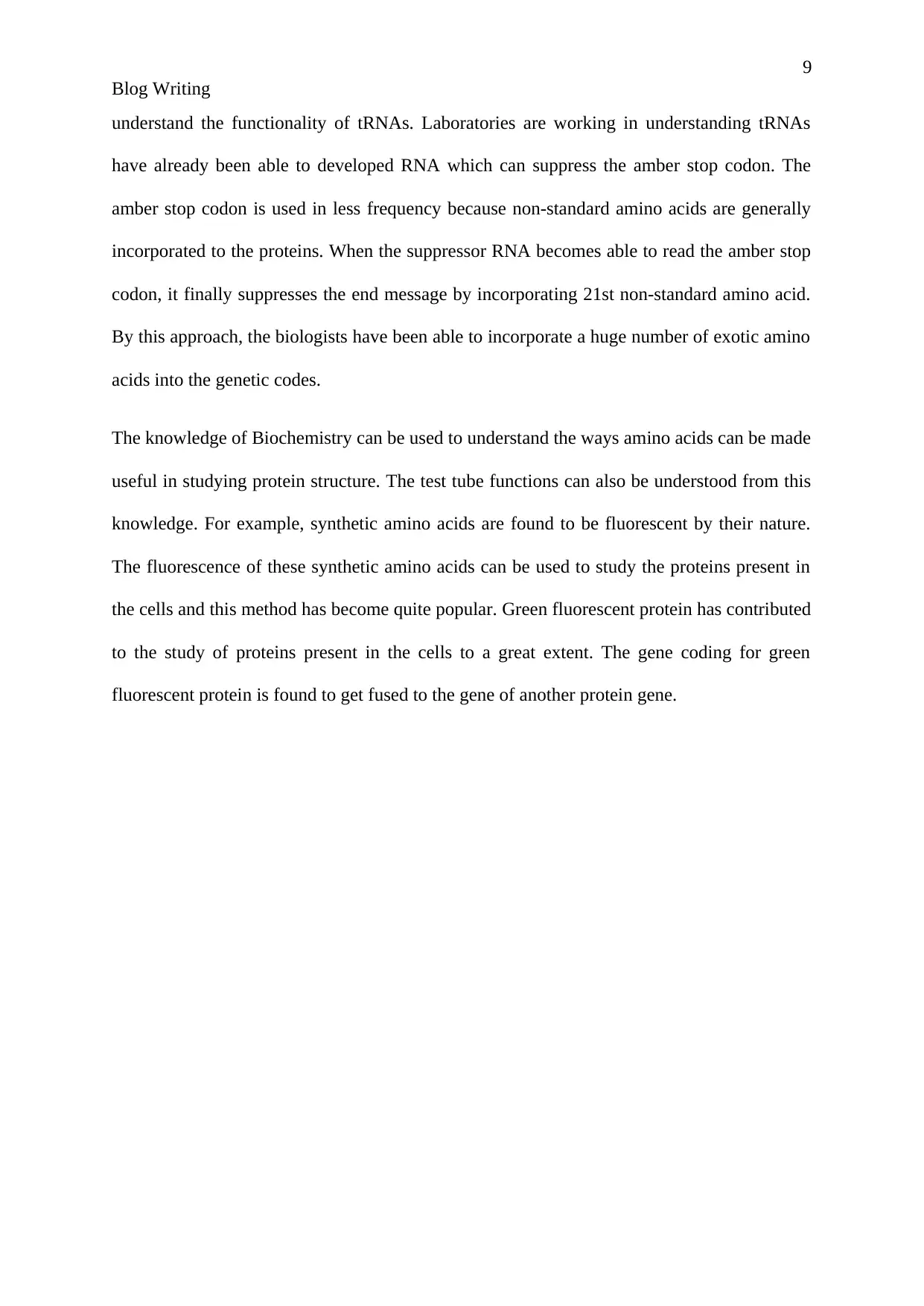
9
Blog Writing
understand the functionality of tRNAs. Laboratories are working in understanding tRNAs
have already been able to developed RNA which can suppress the amber stop codon. The
amber stop codon is used in less frequency because non-standard amino acids are generally
incorporated to the proteins. When the suppressor RNA becomes able to read the amber stop
codon, it finally suppresses the end message by incorporating 21st non-standard amino acid.
By this approach, the biologists have been able to incorporate a huge number of exotic amino
acids into the genetic codes.
The knowledge of Biochemistry can be used to understand the ways amino acids can be made
useful in studying protein structure. The test tube functions can also be understood from this
knowledge. For example, synthetic amino acids are found to be fluorescent by their nature.
The fluorescence of these synthetic amino acids can be used to study the proteins present in
the cells and this method has become quite popular. Green fluorescent protein has contributed
to the study of proteins present in the cells to a great extent. The gene coding for green
fluorescent protein is found to get fused to the gene of another protein gene.
Blog Writing
understand the functionality of tRNAs. Laboratories are working in understanding tRNAs
have already been able to developed RNA which can suppress the amber stop codon. The
amber stop codon is used in less frequency because non-standard amino acids are generally
incorporated to the proteins. When the suppressor RNA becomes able to read the amber stop
codon, it finally suppresses the end message by incorporating 21st non-standard amino acid.
By this approach, the biologists have been able to incorporate a huge number of exotic amino
acids into the genetic codes.
The knowledge of Biochemistry can be used to understand the ways amino acids can be made
useful in studying protein structure. The test tube functions can also be understood from this
knowledge. For example, synthetic amino acids are found to be fluorescent by their nature.
The fluorescence of these synthetic amino acids can be used to study the proteins present in
the cells and this method has become quite popular. Green fluorescent protein has contributed
to the study of proteins present in the cells to a great extent. The gene coding for green
fluorescent protein is found to get fused to the gene of another protein gene.
⊘ This is a preview!⊘
Do you want full access?
Subscribe today to unlock all pages.

Trusted by 1+ million students worldwide
1 out of 9
Related Documents
Your All-in-One AI-Powered Toolkit for Academic Success.
+13062052269
info@desklib.com
Available 24*7 on WhatsApp / Email
![[object Object]](/_next/static/media/star-bottom.7253800d.svg)
Unlock your academic potential
Copyright © 2020–2025 A2Z Services. All Rights Reserved. Developed and managed by ZUCOL.





